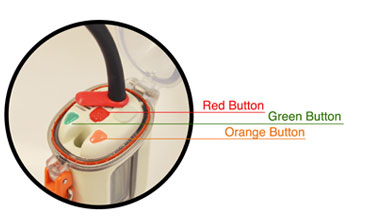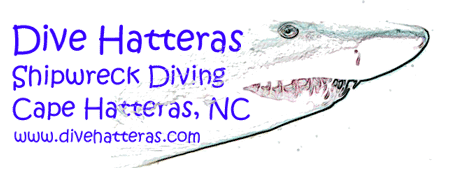|
 Operation
of the Lifeline is very simple and easy using just three buttons
on the radio. The first
button is GREEN and it allows the
diver to talk with the boat on a selectable "chat"
channel for routine
communication. The second button is ORANGE
and this button is preset to
talk on VHF channel 16, which is the marine hailing and distress
channel that most all boats monitor. Operation
of the Lifeline is very simple and easy using just three buttons
on the radio. The first
button is GREEN and it allows the
diver to talk with the boat on a selectable "chat"
channel for routine
communication. The second button is ORANGE
and this button is preset to
talk on VHF channel 16, which is the marine hailing and distress
channel that most all boats monitor.
The third button is the RED
button under the movable shield. This button activates the
emergency call message and sends out a DSC distress message.
This is a digital broadcast that includes your GPS location and information
about the identity of the radio using the encoded MMSI data.
Because this is a digital broadcast the range of the radio greatly increases over a voice call.
ANY modern Marine VHF radio within
range will receive this digital emergency call and activate an
alarm to alert the receiving radio operators of the distress
call. The USCG monitors the frequency of these DSC calls
24/7 using their Rescue 21 system. On our boat the location
of the emergency call shows up on our GPS network displays
allowing us to pilot the boat right to the spot. The RED
button only functions if you have followed through on the radio
registration and obtained a unique MMSI number for your unit, all
done from your PC over the internet for free - no cost.
The Nautilus Lifeline is extremely
simple to set up and use: You fully charge the unit (using
USB) prior to
first use and check the charge status prior to diving. Using
a simple program, downloaded for free from the Nautilus Lifeline
site, you register your unit and can also update the firmware and
software automatically as needed. You can select the VHF
radio channels you want in your Lifeline for the region you are
going to be diving. All this is done using a simple USB
connection.
The pre-dive check is fast and
easy. You push the ORANGE
button
three times very quickly and the Nautilus does a system check and
gives you a "Good to GO" right on the screen. You
then inspect the O Ring seal and close up the unit and you are
dive ready to 425fsw!
|

